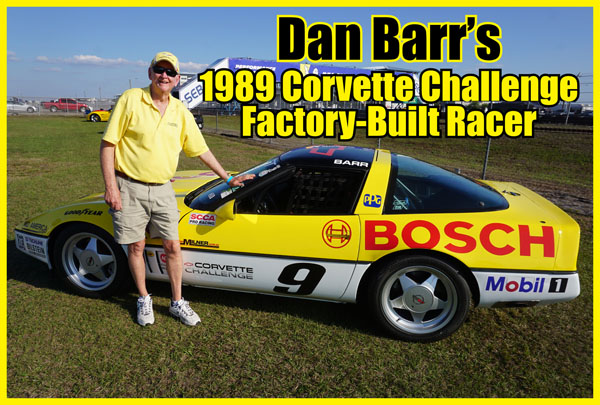A Look Back at the First-Ever Factory-Built Customer Spec Race Cars
Get Into the Time Machine Inside Your Head
Imagine for just a little while that it’s 1988-1989 and you know nothing about Z06 Corvettes, supercharged Corvettes, or mid-engine Corvettes, and the Corvette ZR-1 “King of the Hill” super-Vette is just over the horizon.
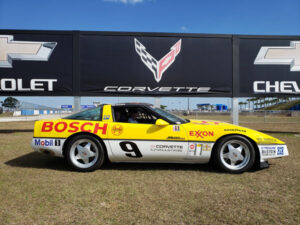 The times were very good for Corvette and the new C4. With massive tires and modern suspension, the C4 could go around corners like never before. In 1985 electronic-controlled fuel injection was back and Car and Driver proclaimed the Corvette, “The Fastest Car In America”, clocking at 150 mph! Starting in 1985, Corvettes became the new “Untouchables” and started a three-year total domination in SCCA’s Showroom Stock racing.
The times were very good for Corvette and the new C4. With massive tires and modern suspension, the C4 could go around corners like never before. In 1985 electronic-controlled fuel injection was back and Car and Driver proclaimed the Corvette, “The Fastest Car In America”, clocking at 150 mph! Starting in 1985, Corvettes became the new “Untouchables” and started a three-year total domination in SCCA’s Showroom Stock racing.
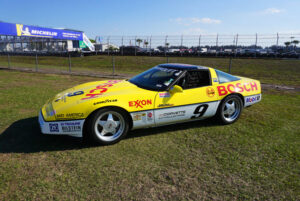 The competition was so flummoxed, Porsche bought a C4 to take apart to see why the car was so damn fast. Corvette fans enjoyed seeing Porsche eat some Humble Pie. Of course, the situation couldn’t run on too long. Rather than tell the other sports car manufacturers, to build a better car, Corvette was kicked out of the Showroom Stock Series. Yes, kicked out for being too fast! This is an amazing thing to consider because early C4s are the cheapest, least respected Corvettes around. Fans loved the Showroom Stock Series because they knew, “I own one of those too!”.
The competition was so flummoxed, Porsche bought a C4 to take apart to see why the car was so damn fast. Corvette fans enjoyed seeing Porsche eat some Humble Pie. Of course, the situation couldn’t run on too long. Rather than tell the other sports car manufacturers, to build a better car, Corvette was kicked out of the Showroom Stock Series. Yes, kicked out for being too fast! This is an amazing thing to consider because early C4s are the cheapest, least respected Corvettes around. Fans loved the Showroom Stock Series because they knew, “I own one of those too!”.
But the Party Wasn’t Over
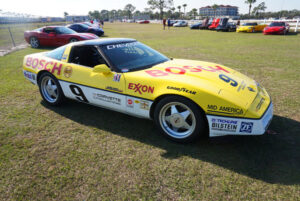 Corvette performance was back and race promoter John Powel, from Toronto, Canada wasn’t about to tuck tail and complain. Powel pitched Chevrolet the idea of a million-dollar, ten-race series with equally-prepared Corvettes. Chevrolet was warm to the idea, as they were heavily involved in NASCAR, the Callaway B2K Twin-Turbo was an official Corvette option, and the all-aluminum, double-overhead-cam (DOHC) ZR-1 was in the works.
Corvette performance was back and race promoter John Powel, from Toronto, Canada wasn’t about to tuck tail and complain. Powel pitched Chevrolet the idea of a million-dollar, ten-race series with equally-prepared Corvettes. Chevrolet was warm to the idea, as they were heavily involved in NASCAR, the Callaway B2K Twin-Turbo was an official Corvette option, and the all-aluminum, double-overhead-cam (DOHC) ZR-1 was in the works.
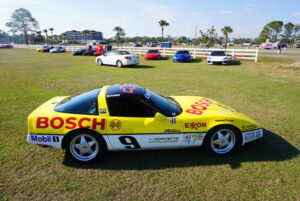 The new Corvette-only series was called, “The Corvette Challenge Series” and it came together quickly. The concept wasn’t new, as the International Race of Champions Series (IROC) had been around since 1974. IROC was launched with Porsche Carrera RSR cars that proved to be too expensive to build and maintain. From 1975 to 1989 it was an all-Camaro series.
The new Corvette-only series was called, “The Corvette Challenge Series” and it came together quickly. The concept wasn’t new, as the International Race of Champions Series (IROC) had been around since 1974. IROC was launched with Porsche Carrera RSR cars that proved to be too expensive to build and maintain. From 1975 to 1989 it was an all-Camaro series.
The 1988 Corvette Challenge Cars
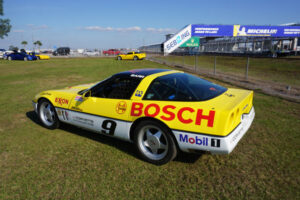 While the basic formula is the same as the IROC Camaros. The cars rolled off the Bowling Green assembly line as “RPO B9B” with the same options that included the following; the Z51 Performance Handling Package that included the new Bosch ABS II, larger-diameter stabilizer bars, Bilstein shocks, restyled 17×9.5-inch wheels with twelve cooling slots, shod with P275ZR17 Goodyear tires, higher-rate springs, a finned power steering cooler, larger 13.1”x1-1/6” front brake rotors and duel-piston calipers, the Doug Nash 4-3 manual transmission, 6-way power driver’s seat, a Delco-Bose stereo radio, Rear Window + Side Mirror Defogger, and removable blue-tinted roof panel. The 1988 Corvette base price was $29,489 and the additional options brought to total to around $33,500.
While the basic formula is the same as the IROC Camaros. The cars rolled off the Bowling Green assembly line as “RPO B9B” with the same options that included the following; the Z51 Performance Handling Package that included the new Bosch ABS II, larger-diameter stabilizer bars, Bilstein shocks, restyled 17×9.5-inch wheels with twelve cooling slots, shod with P275ZR17 Goodyear tires, higher-rate springs, a finned power steering cooler, larger 13.1”x1-1/6” front brake rotors and duel-piston calipers, the Doug Nash 4-3 manual transmission, 6-way power driver’s seat, a Delco-Bose stereo radio, Rear Window + Side Mirror Defogger, and removable blue-tinted roof panel. The 1988 Corvette base price was $29,489 and the additional options brought to total to around $33,500.
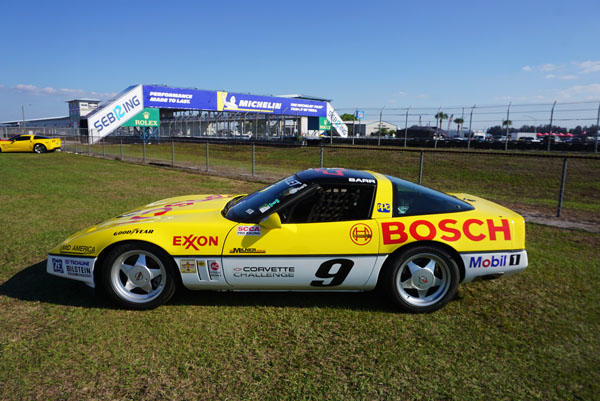 The L98 engines were specially-built at the Flint, Michigan plant and calibrated to equal horsepower levels, and sent to Bowling Green for assembly. Each engine’s bolts and screws were painted with special paint that could only be seen in low light with laser light to verify that the engine had not been tampered with. Fifty-six cars were built and forty-five of the cars were sent to Protofab, in Wixom, Michigan for preparation. “Protofab” later became Pratt & Miller.
The L98 engines were specially-built at the Flint, Michigan plant and calibrated to equal horsepower levels, and sent to Bowling Green for assembly. Each engine’s bolts and screws were painted with special paint that could only be seen in low light with laser light to verify that the engine had not been tampered with. Fifty-six cars were built and forty-five of the cars were sent to Protofab, in Wixom, Michigan for preparation. “Protofab” later became Pratt & Miller.
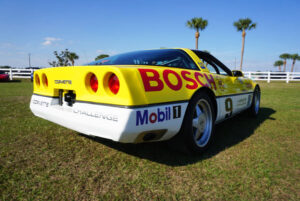 Each car received a roll cage, a racing seat, a safety harness, a fire suppression system, PBR racing brake pads and ducting, a low-restriction Desert Driveline exhaust, Dymag magnesium wheels with shaved-to-half-depth Goodyear tires, and special “Corvette Challenge” emblems. The Protofab preparation cost $15,000 for a grand total of $48,043. That’s just over $124,000 in 2023 dollars. Race cars have never been cheap.
Each car received a roll cage, a racing seat, a safety harness, a fire suppression system, PBR racing brake pads and ducting, a low-restriction Desert Driveline exhaust, Dymag magnesium wheels with shaved-to-half-depth Goodyear tires, and special “Corvette Challenge” emblems. The Protofab preparation cost $15,000 for a grand total of $48,043. That’s just over $124,000 in 2023 dollars. Race cars have never been cheap.
The 1989 Corvette Challenge Cars
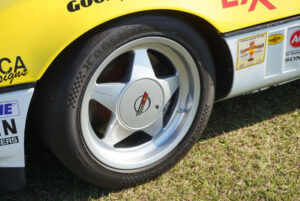 The 1989 Challenge cars used the same formula, but with a few changes. Sixty RPO R7F Challenge cars came off the Bowling Green assembly line with the same package as the 1988 cars, but with the new-and-improved ZF 6-speed transmission. Upon completion, twenty-nine Challenge cars were sent to Powell Development America for the same preparation as the 1988 cars but received straight-through exhaust that exited the side out the rear fenders and a roll cage with sidebars.
The 1989 Challenge cars used the same formula, but with a few changes. Sixty RPO R7F Challenge cars came off the Bowling Green assembly line with the same package as the 1988 cars, but with the new-and-improved ZF 6-speed transmission. Upon completion, twenty-nine Challenge cars were sent to Powell Development America for the same preparation as the 1988 cars but received straight-through exhaust that exited the side out the rear fenders and a roll cage with sidebars.
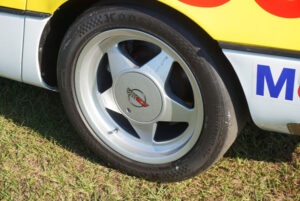 During the 1988 Series, there were complaints that some cars had more horsepower. To assure this was not happening, an electronic telemetry box was installed in place of the passenger-side airbag to monitor engine output. And to keep things fair, ten cars per race were monitored in random sequence.
During the 1988 Series, there were complaints that some cars had more horsepower. To assure this was not happening, an electronic telemetry box was installed in place of the passenger-side airbag to monitor engine output. And to keep things fair, ten cars per race were monitored in random sequence.
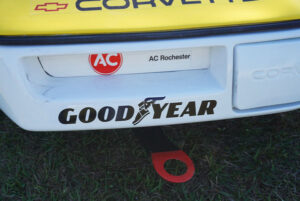 Unlike the 1988 Challenge cars that were built on the assembly line with certified, equally-built engines, they came off the line with the stock L98 engines. The stock, numbers-matching engines were crated and stored with Powell so that if the owner ever wanted to take his car back to “stock”, he could. Again, the L98 engines were assembled for identical power. According to Dan Barr, owner of the #9 Bosch Challenge Corvette, the power output was around 300 horsepower. While all Challenge cars were “purpose-built” race cars, they were all street-legal and carried the full factory warranty. The window sticker for Dan Barr’s Challenge Corvette totaled, $36,193. (around $89,500 in 2023 dollars) Continue reading “Dan Barr’s 1989 Factory-Built Corvette Challenge Race Car”
Unlike the 1988 Challenge cars that were built on the assembly line with certified, equally-built engines, they came off the line with the stock L98 engines. The stock, numbers-matching engines were crated and stored with Powell so that if the owner ever wanted to take his car back to “stock”, he could. Again, the L98 engines were assembled for identical power. According to Dan Barr, owner of the #9 Bosch Challenge Corvette, the power output was around 300 horsepower. While all Challenge cars were “purpose-built” race cars, they were all street-legal and carried the full factory warranty. The window sticker for Dan Barr’s Challenge Corvette totaled, $36,193. (around $89,500 in 2023 dollars) Continue reading “Dan Barr’s 1989 Factory-Built Corvette Challenge Race Car”

